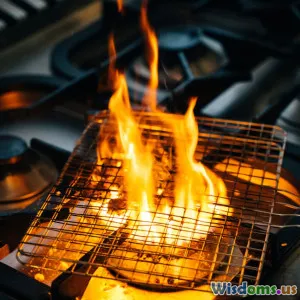
Cooking Techniques for Home Chefs
7 min read Master core cooking techniques that elevate your home meals and boost kitchen confidence. (0 Reviews)
Cooking Techniques for Home Chefs: Elevate Your Everyday Meals
Cooking at home can feel both rewarding and challenging. If you've ever wondered how professional chefs achieve tender meats, crisp vegetables, or richly flavored sauces, the secret often lies in mastering key cooking techniques. This comprehensive guide dives into essential methods that home cooks can adopt to improve flavor, texture, and presentation of their meals.
Why Technique Matters
Cooking isn’t just about following a recipe. It’s a skill, grounded in technique, that transforms raw ingredients into delightful dishes. For instance, proper searing locks in moisture for juicy steaks, and slow braising can convert tougher cuts into melt-in-your-mouth delicacies.
Each technique affects food temperature, moisture, flavor development, and texture differently. Understanding and applying them will not only elevate flavors but also build confidence in the kitchen, helping turn cooking into a creative and enjoyable experience.
Essential Techniques for Home Chefs
1. Sautéing: Quick and Flavorful
Sautéing involves cooking food quickly over relatively high heat in a small amount of fat, typically oil or butter. It’s perfect for vegetables, small cuts of meat, and seafood.
Tips for perfect sautéing:
- Use a wide, heavy skillet (a cast-iron or stainless steel pan works best) to ensure even heat distribution.
- Avoid overcrowding the pan; giving food space allows it to brown and not steam.
- Preheat your pan before adding oil to prevent sticking.
Example: Quickly sautéing garlic and shrimp with a splash of lemon juice creates a flavorful dish that can be served over pasta or salad.
2. Roasting: Bringing Out Deep Flavors
Roasting cooks food evenly in an oven, often at higher temperatures (350–450°F), allowing caramelization and Maillard browning reactions to develop complex flavors.
This method works well for meats, root vegetables, and even fruits.
Scientific insight: Maillard reactions start around 285°F (140°C), producing browned flavors and appealing aromas.
Pro tip: Toss vegetables with oil and seasonings, then roast on a rimmed baking sheet in a single layer for maximum crispness.
3. Braising: Tenderizing Tough Cuts
Braising is a cooking process that uses both moist and dry heat. Typically, meat or vegetables are first seared, then slowly cooked in liquid at low temperatures.
This method breaks down collagen in tougher cuts like brisket or pork shoulder, resulting in tender, richly flavored dishes.
Example: Classic beef stew involves braising chunks of beef with vegetables in beef stock and herbs for several hours.
Kitchen tip: Use a heavy pot with a tight-fitting lid, such as a Dutch oven, to keep moisture in during cooking.
4. Grilling: Smoky and Charred Taste
Grilling exposes food directly to radiant heat, often over charcoal or gas flames. The process imparts a smoky flavor and distinctive grill marks prized in many cuisines.
Proper grilling requires managing heat zones and maintaining grill cleanliness.
Expert advice: Marinate meats in advance and bring them to room temperature before grilling to ensure even cooking.
5. Steaming: Healthy and Gentle
Steaming cooks food by surrounding it with hot steam, preserving nutrients and moisture without added fats.
This method is especially good for vegetables, fish, and dumplings.
Nutritional benefit: Steamed vegetables retain more vitamin C and antioxidants compared to boiling, based on studies published by the USDA.
Practical tip: Line steamers with parchment paper or cabbage leaves to prevent sticking.
6. Sous Vide: Precision Cooking at Home
Sous vide involves sealing food in vacuum bags and cooking it in a water bath at precise temperatures for extended times.
It guarantees perfectly cooked proteins and vegetables by eliminating overcooking.
Though once exclusive to professionals, affordable immersion circulators have made sous vide accessible for home chefs.
For example: Cooking a chicken breast sous vide at 140°F for 1.5 hours results in juicy, tender meat every time.
7. Baking: Science and Art Combined
Baking uses dry heat in an oven—essential for bread, pastries, and casseroles.
It requires an understanding of ingredients’ interactions, rising agents like yeast or baking powder, and temperature control.
Fact: Oven spring, the rapid rise during the first few minutes of baking bread, occurs from yeast activity and steam expansion.
Technique tip: Rotating baking trays midway ensures even browning.
Integrating Techniques for Cooking Success
Often, impressive home dishes result from combining techniques. For example, roast a whole chicken (roasting), then shred the meat and sauté with vegetables (sautéing), or braise ribs and finish on the grill for smoky caramelization.
Experimentation, backed by these foundation techniques, opens endless culinary possibilities.
Conclusion: Empowering the Home Kitchen
Mastering cooking techniques pulls back the curtain on everyday meal preparation, transforming it into an artful practice. When home chefs understand the why and how behind methods like sautéing, roasting, braising, or sous vide, the kitchen becomes a playground of creation and discovery.
As Julia Child famously said, “No one is born a great cook, one learns by doing.” Start with these essential techniques, practice thoughtfully, and watch your confidence—and flavors—soar.
Ready to transform your home cooking? Pick one technique to master this week and savor the delicious progress!
Rate the Post
User Reviews
Popular Posts





















